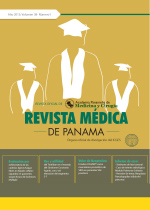Evaluación De La Capacidad De La Citología Cervicovaginal Para Detectar Recurrencias De Cancer Cervicouterino.
Autores/as
DOI:
https://doi.org/10.37980/im.journal.rmdp.2017470Resumen
[Evaluation of Cervicovaginal Cytology Capacity to Detect Cervical Cancer Recurrences.]
Resumen
Objetivo: Evaluar la capacidad de la citología cervicovaginal convencional en detectar recurrencias en el seguimiento de pacientes tratadas por cáncer cervicouterino. Métodos: Se realizó un estudio de cohorte retrospectivo con 483 pacientes con diagnóstico de cáncer cervicouterino en el Instituto Oncológico Nacional(ION) de Panamá en el período de 2012 a 2015 y se evalúo la capacidad diagnostica de la citología cervicovaginal convencional para detectar recurrencia de cáncer de cérvix.Resultados: De las 483 pacientes tratadas por cáncer cervicouterino, 65 (13%) presentaron recurrencias.Las recurrencias fueron detectadas por citología cervicovaginal convencional sólo en 7 pacientes (11%). La sensibilidad de la citología cervicovaginal fue de 11% con una especificidad de 100%. El VPP fue de 100% y el VPN de 88%. El cociente de probabilidad negativo fue de 0.89. La tasa de falsos positivos fue de 0% y la de falsos negativos de 89%. Conclusiones: La citología cervicovaginal de rutina no demostró sensibilidad adecuada para la detección de las recurrencias.La mayoría de las pacientes presentaron recurrencias sintomáticas asociadas a citologías negativas.
Abstract
Objective: To evaluate the ability of conventional cervicovaginal cytology to detect recurrences in the follow-up of patients treated for cervical cancer. Methods: A retrospective cohort study was conducted with 483 patients with a diagnosis of cervical cancer at the National Oncological Institute (ION) of Panama in the period from 2012 to 2015, and the diagnostic capacity of conventional cervicovaginal cytology to detect cancer recurrence was evaluated. of the cervix. Results: Of the 483 patients treated for cervical cancer, 65 (13%) presented recurrences. Recurrences were detected by conventional cervicovaginal cytology in only 7 patients (11%). The sensitivity of cervicovaginal cytology was 11% with a specificity of 100%. The VPP was 100% and the NPV was 88%. The negative likelihood ratio was 0.89. The false positive rate was 0% and the false negative rate was 89%. Conclusions: The routine cervicovaginal cytology did not demonstrate adequate sensitivity for the detection of recurrences. The majority of the patients presented symptomatic recurrences associated with negative cytologies.
Publicado
Número
Sección
Licencia
Derechos autoriales y de reproducibilidad. La Revista Médica de Panama es un ente académico, sin fines de lucro, que forma parte de la Academia Panameña de Medicina y Cirugía. Sus publicaciones son de tipo acceso gratuito de su contenido para uso individual y académico, sin restricción. Los derechos autoriales de cada artículo son retenidos por sus autores. Al Publicar en la Revista, el autor otorga Licencia permanente, exclusiva, e irrevocable a la Sociedad para la edición del manuscrito, y otorga a la empresa editorial, Infomedic International Licencia de uso de distribución, indexación y comercial exclusiva, permanente e irrevocable de su contenido y para la generación de productos y servicios derivados del mismo. En caso que el autor obtenga la licencia CC BY, el artículo y sus derivados son de libre acceso y distribución.






